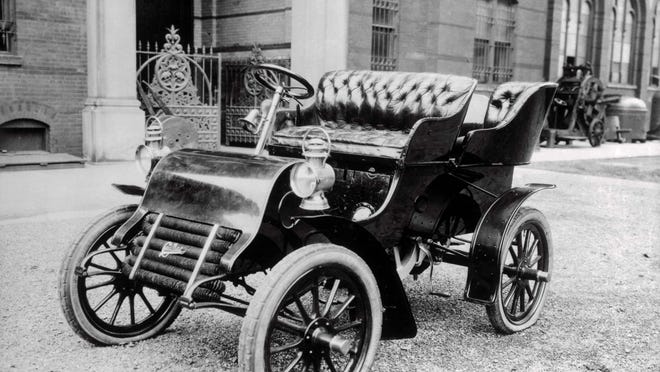38-inch tailfins and 16-cylinder engines: milestones in Cadillac history
 Henry Payne
Henry Payne
The unveiling Thursday of Cadillac’s 2022 Lyriq SUV marks the brand’s dramatic turn to battery power. The new direction is in keeping with a company that, since its founding in 1902, has been synonymous with luxury innovation.
“Craftsmanship is a vocation, precision is a law” was the motto of Henry Martyn Leland, the gifted machinist who ran the company from 1904 to 1922. Leland pioneered standardized spare parts so that, for example, a faulty piston could be changed without having to swap out for an entire new engine.
A culture of innovation followed creating automotive breakthroughs like the first electric self-starter, first enclosed car, and first V-8 engine. Even as Cadillac’s luster dulled at the end of the 20th century as German automakers upped their games, the brand has continued to innovate. Among its most recent accomplishments is the head-up display in 2003.
Here are some of the Lyriq’s key forefathers in Cadillac’s 118-year history.

1902 Model A
Cadillac rose from the ashes of the failed Henry Ford Co. (He moved on to the successful Ford Motor Co. with new investors). So the first Cadillac was nearly identical to the Ford-designed Model A chassis, which Ford Motor Co. also produced in 1903. The 1903 Cadillac Model A sold 2,497 in its first year. About 7 horsepower turned the rear wheels. It came in 2 and 4-door models starting at $850.

1905 Osceola
The 1905 Osceola concept would eventually become the 1910 Model 30 (30 for 30 horsepower), the first car with a fully-enclosed body. Coveted for its privacy, the towering car stood 7-foot-2 — the tallest Cadillac ever made, a foot taller than today’s Escalade SUV.

1912 Model 30
Goodbye, cranky hand crank. The ’12 Model 30 introduced the first electric self-starter. It effectively destroyed the already pricey electric-car market which women drivers in particular had enjoyed for their less physical push starters.

1915 Type 51
As the four-cylinder Model 30 aged, competitors ate into sales with smooth 6-cylinder engines. Cadillac sales cratered in 1914. With furious innovation, Leland & company answered with the first V-8 powered car – the Type 51 – boasting 5.1-liters of piston and 70 horsepower. V-8s still motivate Cadillacs to this day.

1927 LaSalle
Known for its engines and quality, Cadillac was considered a stodgily styled brand. As Packard upped the aesthetic bar, Cadillac answered with Harley Earl who would establish Caddy’s “Art and Colour Section” as the the first styling department within an automobile manufacturer. Earl penned the 1927 LaSalle, a second brand made by Cadillac. Cadillac would endure as a cutting-edge design firm, but LaSalle would not. The name was eventually nixed to focus on Cadillacs.

1931 Phaeton
Double the V-8 and you get the V-16 engine, another Cadillac first. The fast, 170-horsepower mill was the heart of vehicles like the Dual Cowl Sport Phaeton. Celebrities like Marlene Dietrich coveted the incomparable V-16s and their long three-ton bods. The Great Depression eventually canceled these land yachts, but they remain valuable collector cars.

1959 Eldorado
After World War II, Earl was inspired by the design of the Lockheed P-38 Lightning fighter plane. He translated that inspiration into Cadillac tail fins. The fins would first appear on the 1948 Sixty Special and become a signature of American car design. The '59 Eldorado was the era’s high point with fins measuring 38 inches tall.

1970 Eldorado
The eighth-generation Eldorado debuted an edgy style that remains a Cadillac signature to this day. It also boasted the biggest mass-produced engine in automotive history. Its 400 horsepower V-8 had a displacement of 8.2 liters – 500 cubic inches.

1985 DeVille
The Lyriq is partly a response to government-imposed, zero-emissions mandates, but 1974 marked the first time the U.S. government demanded fleet-wide mpg rules. The restrictions forced automakers to look for dramatic fuel economy savings, and Cadillac responded with one of the first front-wheel drive designs. The front-wheel drive DeVille was fit with a transverse V-8 engine.

2002 Escalade
Cadillac's first SUV was introduced in 1999 as a response to the popular Lincoln Navigator. Based on GM’s full-size pick-up frame, the Escalade really hit its stride with its blingtastic second-generation 2002 model which inspired a generation of musicians and gained the favor of celebrity athletes. Escalade has spawned a full line of Cadillac SUVs. Its forthcoming 2021 model was introduced by moviemaker Spike Lee earlier this year.

2003 CTS
After a sleepy decade in which Cadillac fell further behind its athletic German competition, the CTS sedan sought to reboot the brand with a dramatic “Art & Science” design on a rear-wheel drive platform. The CTS gained new respect for the brand.

2014 ELR
Sharing the ambitious Chevy Volt’s chassis and plug-in drivetrain, the gorgeous ELR was Cadillac’s first battery-powered car. Dubbed “Volt in a tux,” the ELR could run 40 miles on battery power before a range-extending gas engine kicked in. The design turned heads, but the $75,995 price tag – similar to the Tesla Model S – turned buyers away. The ELR lasted just two years on the market.
Henry Payne is auto critic for The Detroit News. Find him at hpayne@detroitnews.com or Twitter @HenryEPayne.